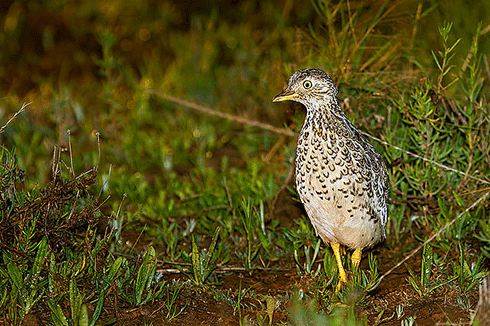
|
Published: 11 August 2014
Let’s hold onto Australian Plains-wanderer: ecologist
The Plains-wanderer, one of the most endangered species of native grasslands in eastern Australia, continues to decline at alarming rates according to ecologist John Morgan.

|
|
Male Plains-wanderer (Pedionomus torquatus). Credit: Patrick_KF9 CC BY 2.0
|
The Plains-wanderer, the sole member of a family of birds called the Pedionomidae, is typically confined to native grasslands in eastern Australia.
A recent major review of the world’s 9993 recognised bird species sought to determine which species we can least afford to lose, in the context of the current high rate of extinction, if we are to maintain maximum global phylogenetic diversity.
The summary metric used in the study to rank the world’s birds combines evolutionary distinctness and extinction risk. The Plains-wanderer was ranked number 1 among Australian birds and number 4 in the world.
According to Professor John Morgan of Latrobe University, this finding highlights how we can ill-afford to lose the species.
Current data suggest that significant declines are being observed.
The two strongholds of the Plains-wanderer are the semi-arid (or xeric) native grasslands of the Riverina region of New South Wales and Victoria’s Northern Plains. Monitoring in New South Wales during 2001-2012 found that the population size declined by 75 per cent during droughts, then recovered slightly during benign years, and was then recorded at record low levels during the very wet years of 2011-12.
The population has remained at very low levels for over a decade, and this is cause for considerable concern. In Victoria there has been monitoring in Terrick Terrick National Park and nearby private land over five years (2010–14).
Numbers declined by over 90 percent during 2011–12 in the wet years (perhaps because breeding was negatively affected, while thickening of grasslands has reduced occupiable habitat) and the numbers have remained at historically low levels.
If ever there was a need to monitor the dynamics of a species of conservation concern, whilst also monitoring its habitat suitability and key determinants of mortality risk (e.g. predation), says Prof. Morgan, then the Plains-wanderer would seem an essential candidate species. Good, basic scientific research is needed to answer simple questions: how long do birds live; are population dynamics cyclic; can suitable habitat be successfully created from scratch?
Prof. Morgan says a metric of the success of grassland conservation and management might be that species like the Plains-wanderers are maintained in their habitat, and that their numbers grow rather than decline.
Source: This news item is adapted from a blog post by Professor John Morgan from La Trobe University. In the post, Prof. Morgan thanks Dr David Baker-Gabb for alerting him to the evolutionary distinctiveness of the Plains-wanderer, and for providing information on the population trends of this species.



